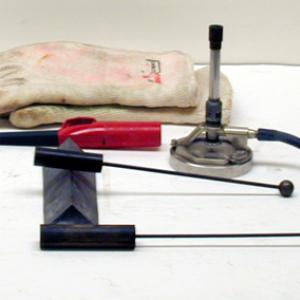College of Liberal Arts & Sciences
4A30.46 - Trevelyan Rockers
Heat the large ends of the Trevelyan Rocker with the Bunsen burner for several minutes. Set it upon the lead brick with the small end of the rocker resting on a table. The rocker will start to vibrate due to the rapid expansion of the lead under the rocker. This rapid expansion causes the rocker to tip so that one edge and then the other is making close contact with the lead. One of these lead blocks is kept in the refrigerator as the greater the difference in temperature between the block and the rocker the better it works. Another interesting note is that the frequency of the rocker will not descend steadily, but will jump from one harmonic to another. NOTE: If the rocker does not start to vibrate spontaneously a gentle bump is enough to start the process.
- Ira M. Freeman, "Department of Forgotten Lore", TPT, Vol. 12, # 6, Sept. 1974, p. 348.
- H- 24: Richard Manliffe Sutton, Demonstration Experiments in Physics.
- George M. Hopkins, "Sound", Experimental Science, p. 163.
- George M. Hopkins', "Some Effects of Large Currents", Experimental Science, Volume Two, p. 337.
- C. L. Stong, "On a Paradoxical Pump, Reversing Cubes, Vortex Rings, and Various Other Matters", The Amateur Scientist, January, 1965.
- Jearl Walker, "Thermal Oscillators: System That Seesaw, Buzz or Howl Under the Influence of Heat", The Amateur Scientist, Feb, 1983.
- Julius Sumner Miller, Q107 & A107, Millergrams I – Some Enchanting Questions for Enquiring Minds, p. 68 & 115.
Disclaimer: These demonstrations are provided only for illustrative use by persons affiliated with The University of Iowa and only under the direction of a trained instructor or physicist. The University of Iowa is not responsible for demonstrations performed by those using their own equipment or who choose to use this reference material for their own purpose. The demonstrations included here are within the public domain and can be found in materials contained in libraries, bookstores, and through electronic sources. Performing all or any portion of any of these demonstrations, with or without revisions not depicted here entails inherent risks. These risks include, without limitation, bodily injury (and possibly death), including risks to health that may be temporary or permanent and that may exacerbate a pre-existing medical condition; and property loss or damage. Anyone performing any part of these demonstrations, even with revisions, knowingly and voluntarily assumes all risks associated with them.
